Fresh asparagus is an early spring vegetable that can be prepared in a variety of different ways. It’s only around for a few months, February through June with April being the peak month.
I’ll show you how to store asparagus so it stays fresh and crisp for at least a week. You’ll learn asparagus tips for buying the freshest, tastiest seasonal vegetable possible and recipes for how to eat asparagus in this ultimate guide.

Want to Save This Article?
Enter your email & I’ll send it straight to your inbox. And you’ll get new recipes & tips each week.
My goal is to help you eat more seasonal, fresh foods. If you’re going to bring these foods into your home, you need to know how to store them properly so they don’t end up in the garbage at the end of the week.
In the past, we’ve talked about how to store some tricky produce items. A few of my favorites:
- Cut carrots and celery and place them in water.
- Store fresh herbs (my favorite being cilantro) and green onions like a bouquet of flowers.
- Wash berries in a vinegar bath.
- Store lettuce with a towel or in a special bin.
- Freeze fresh berries in season.
- Store radishes in a bowl of water.
Today, I want to help your family become asparagus lovers. You’ll learn how to store this vegetable properly and how to eat this spring delicacy.
The Very Best Way to Store Asparagus
If stored improperly, asparagus will dry out within a couple of days, leaving a slimy texture and unpleasant flavor. A fresh bunch of asparagus should be vibrant, dark green, white (for white asparagus), or purple (for purple asparagus) with a crisp “snap” to the stems.
With this storage method, you will extend the life of your asparagus. It will last a week (or longer). I’ve even had it go a couple of weeks in the refrigerator.
Tools you’ll need
This kitchen tip teats the asparagus like a bouquet of flowers, allowing the bottom of the stems to “drink” water, keeping the asparagus well hydrated with a just-picked flavor. The same trick is used to store other tricky produce items, like cilantro, other fresh herbs, and green onions.
Here are the simple steps for the easiest way to store raw asparagus.

Step 1: Trim the Ends
Asparagus has a natural “breaking point” at the woody part of the stem. You can either trim the ends by breaking the asparagus with your hands at this breaking point, or trim off the white ends of the asparagus with a knife. Discard the white ends.

Step 2: Place Asparagus in a Jar
I recommend using a wide-mouth glass jar (like a Mason jar or Weck jar), particularly if the asparagus has thick stems. Place the trimmed asparagus in the jar, in an upright position.
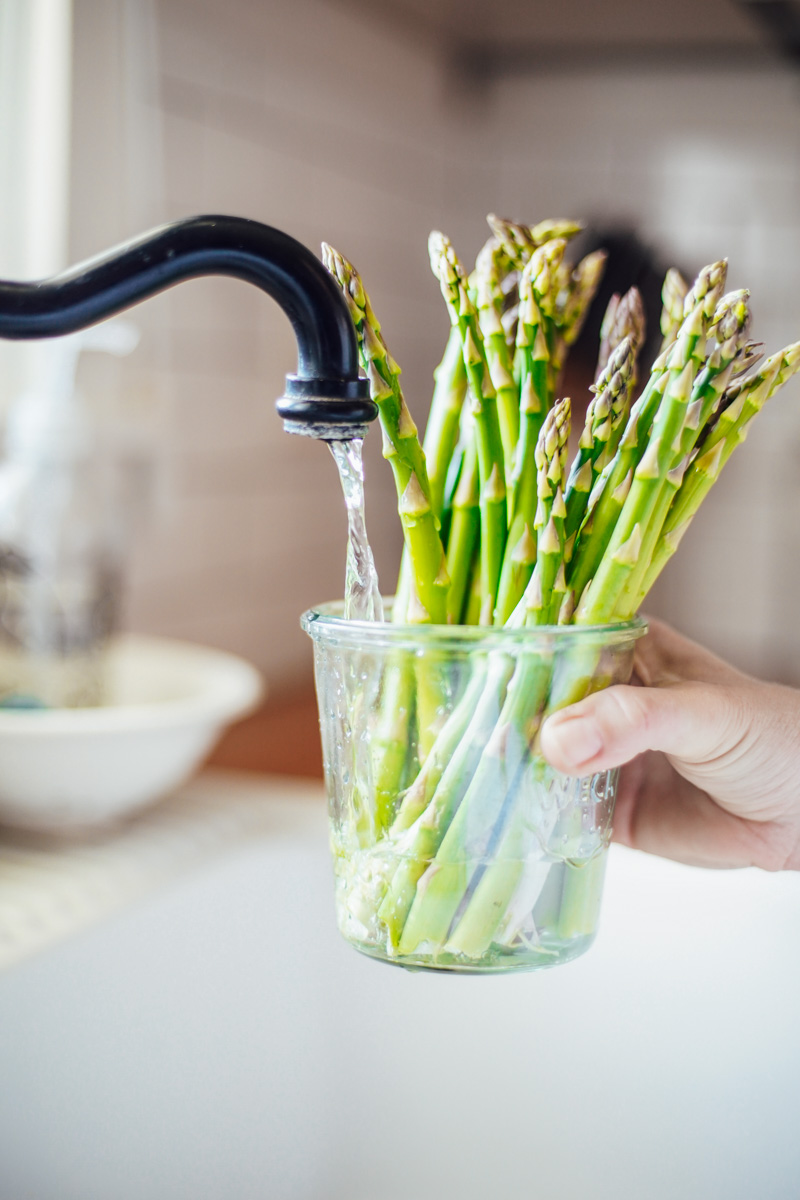
Step 3: Add Water
Fill the jar with about 1 inch of cold water, just enough for the bottom of the stalks to rest in the water and drink it up. And it will drink up that water. So every few days I recommend checking on the water level and refilling as needed.
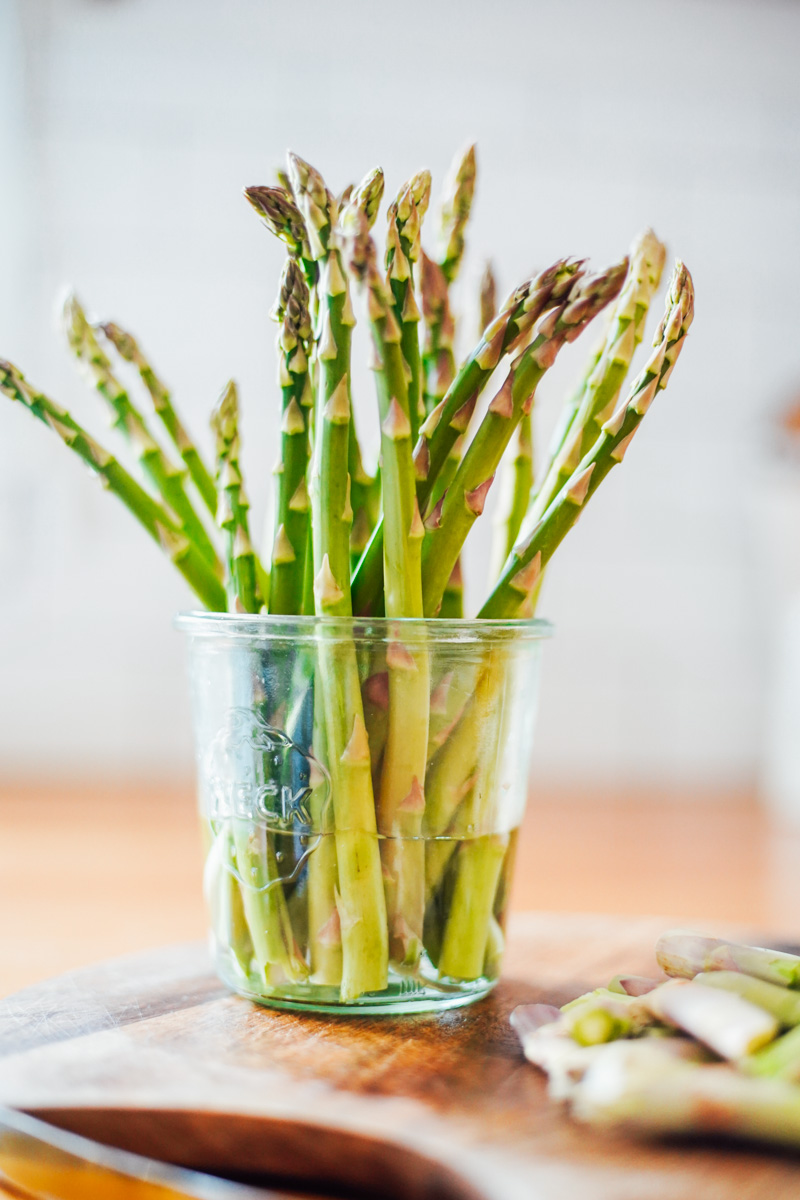
Step 4: Refrigerate
Place the asparagus toward the front of the fridge (the door works well, if you have room). Storing the asparagus in the right place in the fridge is essential.
Avoid placing the asparagus near the ice maker (if that’s inside your fridge) or the back, as these are the coldest spots and will cause the asparagus to freeze.
Some folks like to cover the asparagus with a plastic bag, securing it around the top of the jar with a rubber band (just like we did with cilantro, other fresh herbs, and green onions).
I haven’t found a need to do this with asparagus. Doing so can build up moisture in the bag and cause the tips to rot faster due to a lack of air circulation.
Shelf Life: 7-14 Days
Expect a shelf life of at least a week, or up to 2 weeks from my experience, with this storage method.Just make sure there is always about an inch of water at the bottom of the jar.
Video Guide: How I Store Asparagus
Should fresh asparagus be refrigerated?
Yes, asparagus is a vegetable that should always be stored in the fridge. It will not last at room temperature for longer than a day.

How to Store Asparagus Printable Guide
Ingredients
- 1 wide-mouth glass jar like a mason jar or Weck jar
- water
- 1 lb fresh asparagus
Instructions
- Trim the stems. Asparagus has a natural "breaking point" at the woody part of the stem. Trim the ends by breaking the asparagus with your hands at this breaking point, or trim off the white ends of the asparagus with a knife. Discard the ends.
- Place the trimmed asparagus stalks in a glass jar, in an upright position.
- Fill the jar with about 1 inch of cold water, just enough for the bottom of the stalks to rest in the water.
- Place the asparagus in the fridge. Storing the asparagus in the right place in the fridge is essential. Avoid placing the asparagus near the ice maker (if that's inside your fridge) or the back, as these are the coldest spots and will cause the asparagus to freeze.
Video
Notes
Don’t let it rot!
FREE PRODUCE GUIDE
21 Storage Hacks to Keep Your Produce Fresh
What to look for when buying asparagus?
No matter how you store asparagus, a bad bunch of asparagus is just that. No method will delay the inevitable if the asparagus has already gone bad. Here’s what to look for at the grocery store or farmer’s market:
- Firm, Unwilted Tips: The tips have the most flavor, so it’s important that they are in the most pristine condition. They shouldn’t look dried out, frayed, or slimy. They should appear to be tightly closed.
- Scent: The freshest asparagus shouldn’t have a strong smell. Rotting asparagus will have a strong, “off” smell.
- Crisp Stalks: Asparagus stalks should be crisp; not flimsy and limp. Limp asparagus isn’t just a texture issue; it will have flavor loss as well.
- Vibrant Color: Asparagus may be white, purple, or green. The color should be vibrant; never dull or faded.
- Storage: A grocery store, where asparagus is sitting on the shelf for a few days, should store asparagus upright in either ice or water. This is important as you know it’s been properly stored and cared for before purchasing. A farmer’s market is different, as most produce is picked just before the market.
Asparagus can be found in both thin spears and thicker spears. Many people find the thin spears to have more of a tender bite, but either option is delicious.
When is the best time to buy asparagus?
The very best time to buy asparagus in during its growing season. In North America, this is between the months of February through June, with the peak in April. You’ll get the freshest asparagus during these months.
How can I tell if asparagus is bad?
The tell tale signs of bad asparagus are:
- Slimy, frayed, or dried tips
- A strong, “off” smell, particularly at the tips
- Dull or faded discoloration
- Limp stems
- Flavor loss
- Fuzzy mold growth on the tips
Can I freeze fresh asparagus?
If you want to store asparagus for an extended period, freezing is the best option. Another option is to ferment asparagus.
Just like with freezing fresh radishes, you’ll need to blanch the asparagus first. To do this, cook trimmed asparagus in a large pot of boiling water for a few minutes.
Remove with a slotted spoon and transfer to a large bowl of ice water (an ice bath) to stop the cooking process. Freeze on a sheet pan, then transfer to a freezer bag.
Frozen asparagus will last for 2-3 months in the freezer. Once frozen, it’s best used in cooked recipes, like a casserole or quiche; not a salad. Learn how to freeze asparagus.
How to Eat: 11 Best Recipes & Cooking Ideas
One of the best things about asparagus is how many different ways there are to eat this healthy vegetable. Asparagus can be a main meal (a soup or quiche) or a side dish. And you can eat both raw or cooked asparagus.
Here are a few of my favorite cooking methods and recipes.
Steamed: There’s a delicious tenderness to steamed asparagus. Add an inch of water to a skillet and bring to a boil. Once boiling, add rinsed asparagus, in a steamer basket, to the water. Cover and cook for 3-5 minutes, then remove and top with salt and butter.
Sautéed: Cut asparagus into 1-2 inch pieces. Melt 3 tablespoons butter in a skillet over medium-high heat. Add the asparagus and cook until tender, then add 2 cloves of garlic minced, salt, pepper, and any chopped fresh herbs (dill or parsley are lovely).
Grilled: Preheat a grill to 400F. Place whole asparagus stalks in a shallow bowl and toss with olive oil to coat. Then toss with salt and pepper. Place the stalks on the grill and cook for 6-10 minutes, until tender.
Mini Asparagus Quiche: A great way to prep breakfast in advance. Make mini crust-less quiche with leeks, asparagus, and bacon. Enjoy for breakfast all week.
Frittata: Make a frittata on the weekend with asparagus, eggs, and cheese. A great spring brunch recipe or make this on Sunday to enjoy on busy weekday mornings.
Cream of Asparagus Soup: A spring classic that’s far easier to make than it sounds. Just cream, broth, seasoning, and the star of the show (asparagus). Serve with bread, biscuits, grilled cheese, or quesadillas on the side.
Shaved Asparagus Salad: Arugula, shaved asparagus, parmigiano-reggiano cheese, and nuts make this salad a show stopper!
Prosciutto Wrapped Asparagus: Wrap asparagus in prosciutto and bake at 400F until tender. A great way to serve asparagus as a side dish for Mother’s Day, Easter, a Baby Shower, or just a fun side dish with a spring salad or protein.
Toss with Pasta and Pesto: Grill or saute asparagus, then cut into 1-2 inch pieces. Toss with cooked pasta and homemade pesto. Add grilled chicken breasts for protein, or serve on the side with crispy chicken thighs.
Add to Stir Fry: I make this orange-ginger chicken stir fry almost weekly. It’s a great meal to change up based on what’s in season. Instead of snap peas, add 1-2 inch pieces of asparagus during the spring season.
Asparagus Stuffed Chicken Breasts: One of my favorite dinner meals. Wrap chicken breasts around asparagus spears and bake. Serve with the easiest baked sweet potatoes, Instant Pot mashed potatoes, Instant Pot rice, or your favorite side.






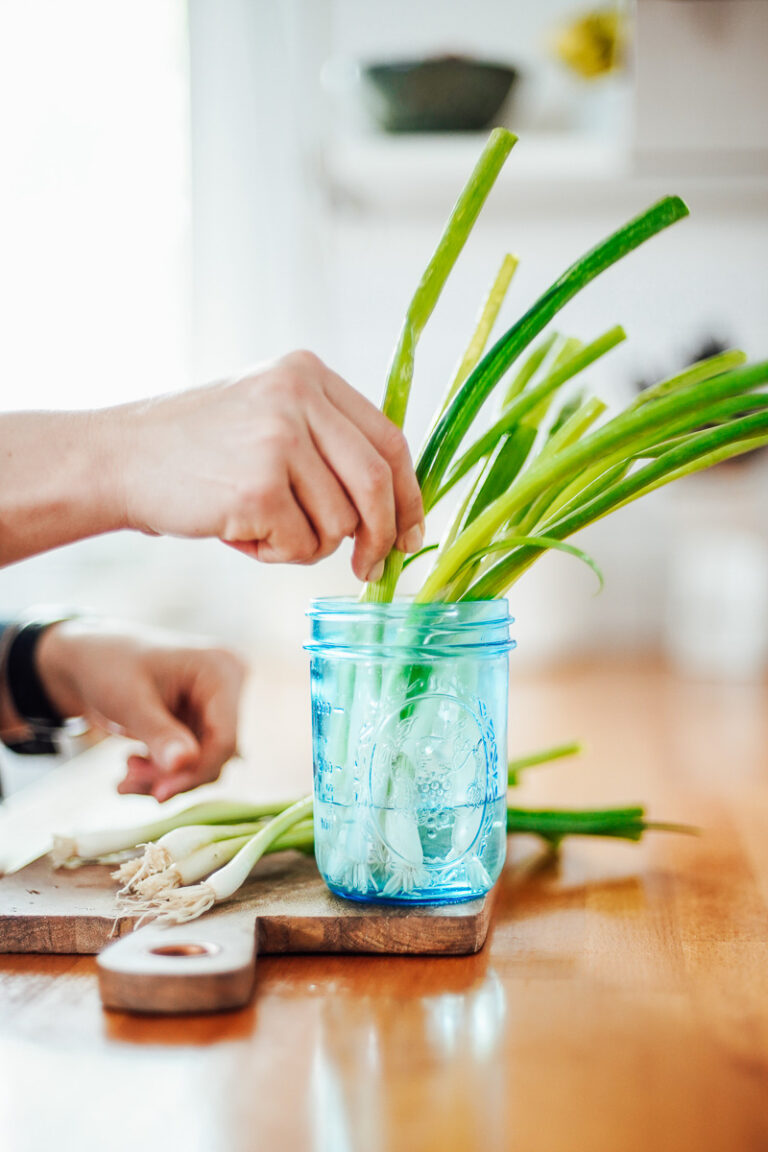
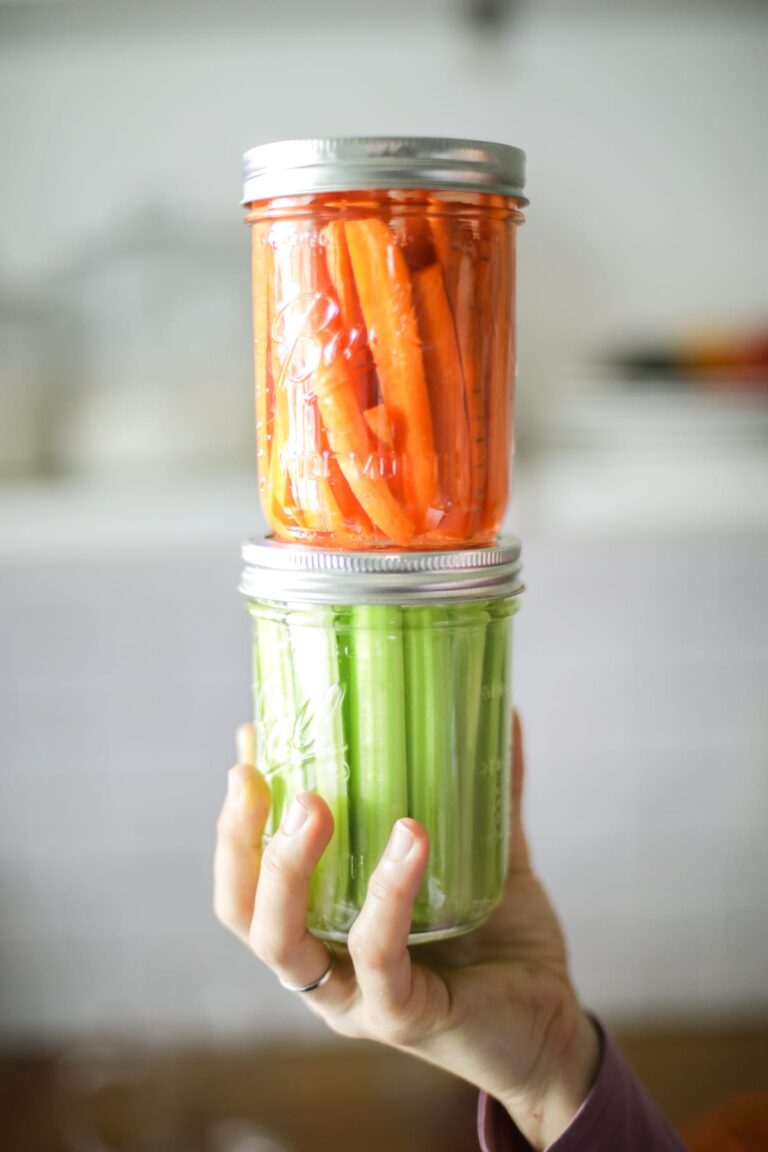

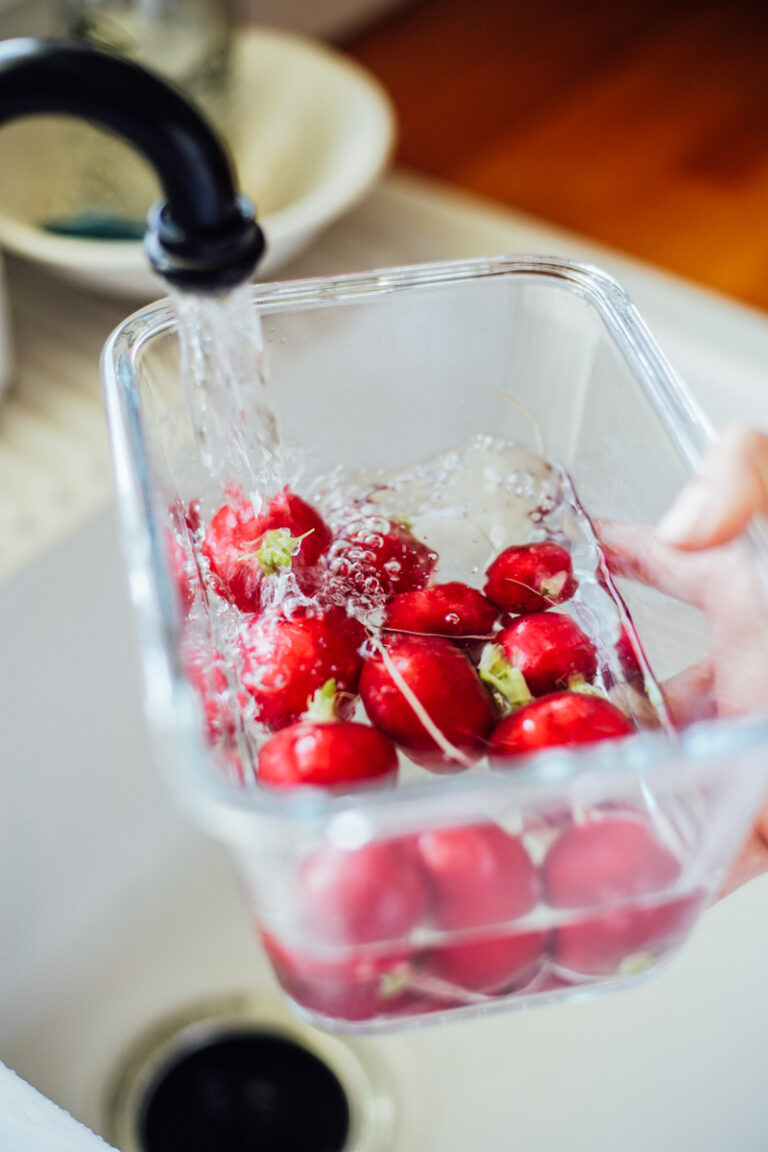
I also store my asparagus in water in the fridge, but do not snap the woodsy ends off till ready to use. I also have found that a ramekin or 16 oz. sour cream container works well and the spears will stand up fine and stay fresh beyond 2 weeks.
That’s awesome, Sherri! Great tips, thanks for sharing.
I am saddened to see so many adds on your website. I used to be avid follower of your blog.
I can barely get to the information I need now from the ads.
Sorry! So disappointing! I understand that money is good but at what ‘cost’?
Hey Michaela, Can you share the exact ads/ad positions that are hard to navigate? Ads are the only thing that pay for the large cost of keeping this site going and free for readers. Without ads, we would have to shut down Live Simply or make it a membership site (where content would only be available to paying readers). We aren’t getting rich off ads. In fact, we’re just getting by running them in order to keep the site going. Traffic numbers and ad dollars have taken a hit over the years, and that means having to place more ads on sites to maintain operating costs.
As you mentioned, we don’t want the experience of the website to be poor (while still being able to bring in the ad dollars needed to keep Live Simply going and provide great info for readers). Knowing which ads are causing a bad experience is super helpful so we can let our ad company know and they can either report these ads or remove them to create a better reader experience.
Please know we value your feedback and are trying to balance both the world of paying for the free content and upkeep of running a blog like this and also making the site a wonderful place for readers to visit and find free recipes and information. I’m so sorry your experience is frustrating and would love to hear about specific ways we could improve the ad placement.
Tell me your favorite way to enjoy asparagus during the spring months!